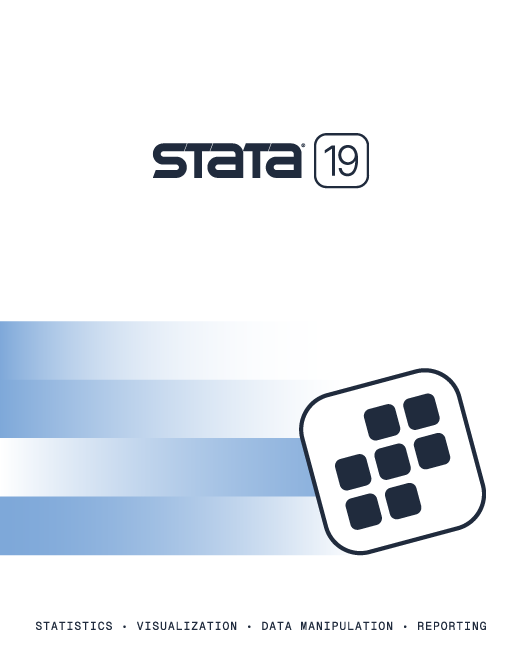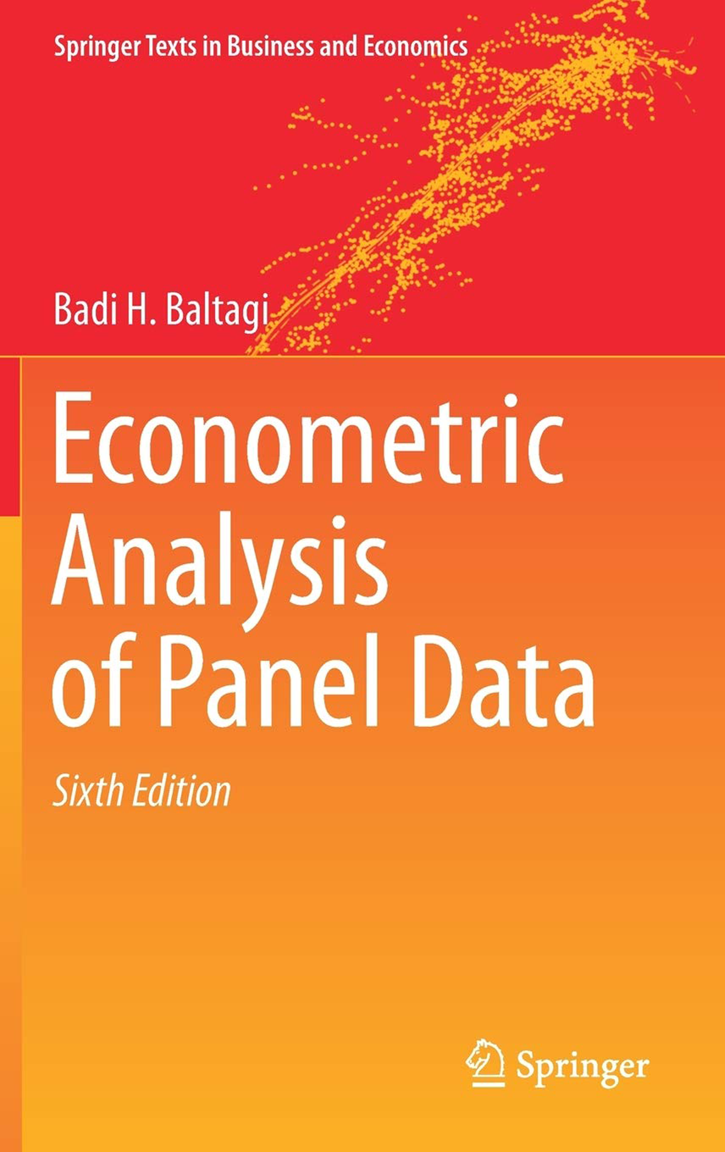

2025 Stata Conference • Nashville, TN • 31 July–01 August
Econometric Analysis of Panel Data, Sixth Edition |
||||||||||||||||||||||||||||||||
 Click to enlarge |

As an Amazon Associate, StataCorp earns a small referral credit from
qualifying purchases made from affiliate links on our site.
eBook not available for this title
eBook not available for this title |
|
||||||||||||||||||||||||||||||
Comment from the Stata technical groupEconometric Analysis of Panel Data, Sixth Edition, by Badi H. Baltagi, is a standard reference for performing estimation and inference on panel datasets from an econometric standpoint. This book provides both a rigorous introduction to standard panel estimators and concise explanations of many newer, more advanced techniques. This book provides an excellent introduction for the student or the applied researcher because of its attention to detail and its use of examples, many of which use Stata. The detail is especially useful in the many sections that grow out of Baltagi’s own work. In these sections, readers gain a deep enough understanding of the models to implement them in a programming language like Stata. In other sections, such as the chapter on limited dependent variables, Baltagi combines a good introduction to the mechanics with an excellent introduction to the literature, allowing readers the opportunity to follow up for more details. The sixth edition has been substantially updated to reflect modern developments in panel-data analysis. This edition also includes new material on dynamic panels, limited dependent variables, nonstationary panels, and spatial panel data. Because of its wide range of topics and detailed exposition, Econometric Analysis of Panel Data, Sixth Edition can serve as both a graduate-level textbook and a handy desk reference for seasoned researchers. |
||||||||||||||||||||||||||||||||
Table of contentsView table of contents >> Table of Contents
Preface
1 Introduction
1.1 Panel Data: Some Examples
1.1.1 Examples of Micro-panels
1.2 Why Should We Use Panel Data? Their Benefits and Limitations 1.1.2 Examples of Macro-panels 1.1.3 Some Basic References 1.3 Note References 2 The One-Way Error Component Regression Model
2.1 Introduction
2.2 The One-Way Fixed Effects Model 2.3 The One-Way Random Effects Model 2.4 Maximum Likelihood Estimation 2.5 Prediction 2.6 Examples
2.6.1 Example 1: Investment Equation
2.7 Selected Applications 2.6.2 Example 2: Gasoline Demand Equation 2.6.3 Example 3: Public Capital Productivity 2.8 Computational Note 2.9 Notes 2.10 Problems References 3 The Two-Way Error Component Regression Model
3.1 Introduction
3.2 The Two-Way Fixed Effects Model
3.2.1 Testing for Fixed Effects
3.3 The Two-Way Random Effects Model
3.3.1 Monte Carlo Results
3.4 Maximum Likelihood Estimation 3.5 Prediction 3.6 Examples
3.6.1 Example 1: Investment Equation
3.7 Computational Note 3.6.2 Example 2: Gasoline Demand Equation 3.6.3 Example 3: Public Capital Productivity 3.8 Notes 3.9 Problems References 4 Test of Hypotheses with Panel Data
4.1 Tests for Poolability
4.1.1 Test for Poolability u~N(0,σ2INT)
4.2 Tests for Individual and Time Effects 4.1.2 Test for Poolability Under the General Assumption u~N(0,Ω) 4.1.3 Examples
4.2.1 The Breusch—Pagan Test
4.3 Hausman's Specification Test 4.2.2 Honda, King and Wu, and the Standardized Lagrange Multiplier Tests 4.2.3 Gourieroux, Holly and Monfort Test 4.2.4 Conditional LM Tests 4.2.5 ANOVA F and the Likelihood Ratio Tests 4.2.6 Monte Carlo Results 4.2.7 An Illustrative Example
4.3.1 Example 1: Investment Equation
4.4 Further Reading 4.3.2 Example 2: Gasoline Demand Equation 4.3.3 Example 3: Canadian Manufacturing Industries 4.3.4 Example 4: Sawmills in Washington State 4.3.5 Example 5: Mariage Premium 4.3.6 Example 6: Currency Union 4.3.7 Hausman's Test for the Two-Way Model 4.5 Notes 4.6 Problems References 5 Heteroskedasticity and Serial Correlation in the Error Component Model
5.1 Heteroskedasticity
5.1.1 Testing for Homoskedasticity in an Error Component Model
5.2 Serial Correlation
5.2.1 The AR(1) Process
5.3 Time-Wise Autocorrelated and Cross-Sectionally Heteroskedastic Panel Regression 5.2.2 The AR(2) Process 5.2.3 The AR(4) Process for Quarterly Data 5.2.4 The MA(1) Process 5.2.5 Unequally Spaced Panels with AR(1) Disturbances 5.2.6 Prediction 5.2.7 Testing for Serial Correlation and Individual Effects 5.4 Further Reading 5.5 Notes 5.6 Problems References 6 Seemingly Unrelated Regressions with Error Components
6.1 The One-Way Model
6.2 The Two-Way Model 6.3 Applications and Extensions 6.4 Problems References 7 Simultaneous Equations with Error Components
7.1 Single Equation Estimation
7.2 Empirical Example: Crime in North Carolina 7.3 System Estimation 7.4 The Hausman and Taylor Estimator 7.5 Empirical Example: Earnings Equation Using PSID Data 7.6 Further Reading 7.7 Notes 7.8 Problems References 8 Dynamic Panel Data Models
8.1 Introduction
8.2 The Arellano and Bond Estimator
8.2.1 Testing for Over-Indentification Restrictions and Serial Correlation in Dynamic Panel Models
8.3 The Arellano and Bover Estimator 8.2.2 Downward Bias of the Estimated Asymptotic Standard Errors 8.2.3 Too Many Moment Conditions and the Bias Efficiency Trade-Off 8.4 The Ahn and Schmidt Moment Conditions 8.5 The Blundell and Bond System GMM Estimator 8.6 The Keane and Runkle Estimator 8.7 Limited Information Maximum Likelihood 8.8 Empirical Examples
8.8.1 Example 1: Dynamic Demand for Cigarettes
8.9 Selected Applications 8.8.2 Example 2: Democracy and Education 8.10 Further Reading 8.11 Notes 8.12 Problems References 9 Unbalanced Panel Data Models
9.1 Introduction
9.2 The Unbalanced One-Way Error Component Model
9.2.1 ANOVA Methods
9.3 Maximum Likelihood Estimators
9.3.1 Minimum Norm and Minimum Variance Quadratic Unbiased Estimators (MINQUE and MIVQUE)
9.4 Empirical Example: Hedonic Housing 9.3.2 Monte Carlo Results 9.5 The Unbalanced Two-Way Error Component Model
9.5.1 The Fixed Effects Model
9.6 Testing for Individual and Time Effects Using Unbalanced Panel Data 9.5.2 The Random Effects Model 9.7 The Unbalanced Nested Error Component Model
9.7.1 Empirical Example: Nested States Public Capital Productivity
9.8 Notes 9.9 Problems References 10 Special Topics
10.1 Measurement Error and Panel Data
10.2 Rotating Panels 10.3 Pseudo-Panels 10.4 Short-Run versus Long-Run Estimates in Pooled Models 10.5 Heterogeneous Panels 10.6 Count Panel Data 10.7 Notes 10.8 Problems References 11 Limited Dependent Variables and Panel Data
11.1 Fixed and Random Logit and Probit Models
11.2 Simulation Estimation of Limited Dependent Variable Models with Panel Data 11.3 Dynamic Panel Data Limited Dependent Variable Models 11.4 Selection Bias in Panel Data 11.5 Censored and Truncated Panel Data Models 11.6 Empirical Applications 11.7 Empirical Example: Nurses Labor Supply 11.8 Further Reading 11.9 Notes 11.10 Problems References 12 Nonstationary Panels
12.1 Introduction
12.2 Panel Unit Roots Tests Assuming Cross-Sectional Independence
12.2.1 Levin, Lin and Chu Test
12.3 Panel Unit Roots Tests Allowing for Cross-Sectional Dependence 12.2.2 Im, Pesaran and Shin Test 12.2.3 Breitung's Test 12.2.4 Combining p-Value Tests 12.2.5 Residual-Based LM Test 12.4 Spurious Regression in Panel Data 12.5 Panel Cointegration Tests
12.5.1 Residual-Based DF and ADF Tests (Kao Tests)
12.6 Estimation and Inference in Panel Cointegration Models 12.5.2 Residual-Based LM Test 12.5.3 Pedroni Tests 12.5.4 Likelihood-Based Cointegration Test 12.5.5 Finite Sample Properties 12.7 Empirical Examples
12.7.1 Example 1: Purchasing Power Parity
12.8 Further Reading 12.7.2 Example 2: International R&D Spillover 12.7.3 Example 3: OECD Health Care Expenditures 12.9 Notes 12.10 Problems References 13 Spatial Panel Data Models
13.1 Introduction
13.2 Spatial Error Component Regression Model 13.3 Spatial Lag Panel Data Regression Model 13.4 Forecasts using Panel Data with Spatial Error Correlation 13.5 Panel Unit Root Tests and Spatial Dependence 13.6 Panel Data Tests for Cross-Sectional Dependence 13.7 Computational Note 13.8 Problems References |
||||||||||||||||||||||||||||||||
Learn
Free webinars
NetCourses
Classroom and web training
Organizational training
Video tutorials
Third-party courses
Web resources
Teaching with Stata
© Copyright 1996–2025 StataCorp LLC. All rights reserved.
×
We use cookies to ensure that we give you the best experience on our website—to enhance site navigation, to analyze usage, and to assist in our marketing efforts. By continuing to use our site, you consent to the storing of cookies on your device and agree to delivery of content, including web fonts and JavaScript, from third party web services.
Cookie Settings
Last updated: 16 November 2022
StataCorp LLC (StataCorp) strives to provide our users with exceptional products and services. To do so, we must collect personal information from you. This information is necessary to conduct business with our existing and potential customers. We collect and use this information only where we may legally do so. This policy explains what personal information we collect, how we use it, and what rights you have to that information.
These cookies are essential for our website to function and do not store any personally identifiable information. These cookies cannot be disabled.
This website uses cookies to provide you with a better user experience. A cookie is a small piece of data our website stores on a site visitor's hard drive and accesses each time you visit so we can improve your access to our site, better understand how you use our site, and serve you content that may be of interest to you. For instance, we store a cookie when you log in to our shopping cart so that we can maintain your shopping cart should you not complete checkout. These cookies do not directly store your personal information, but they do support the ability to uniquely identify your internet browser and device.
Please note: Clearing your browser cookies at any time will undo preferences saved here. The option selected here will apply only to the device you are currently using.